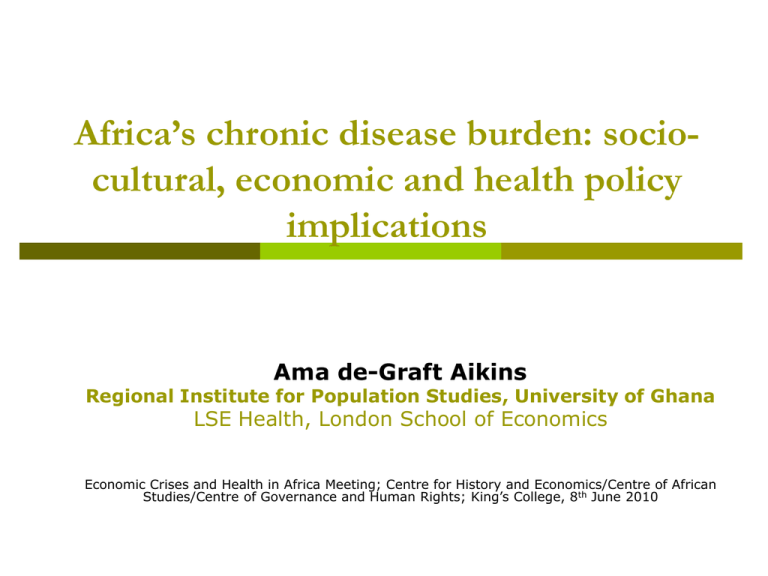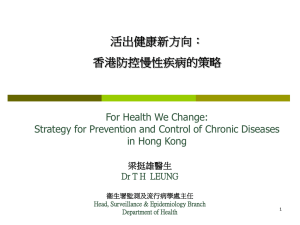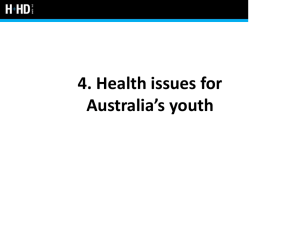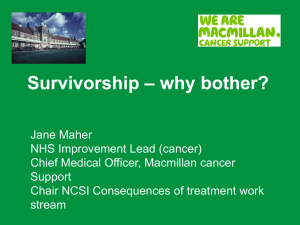
Africa’s chronic disease burden: sociocultural, economic and health policy
implications
Ama de-Graft Aikins
Regional Institute for Population Studies, University of Ghana
LSE Health, London School of Economics
Economic Crises and Health in Africa Meeting; Centre for History and Economics/Centre of African
Studies/Centre of Governance and Human Rights; King’s College, 8th June 2010
Presentation Outline
1.
2.
3.
4.
Africa’s chronic disease burden
Context of the burden
Policy: recommendations and gaps
Socio-cultural, economic, health policy
implications
1. Africa’s chronic disease burden
Only region where infectious diseases still outnumber chronic
diseases* as a cause of death (about 69%)
But age specific mortality rates from chronic diseases as a
whole are higher than in virtually all other regions of the
world, in both men and women (de-Graft Aikins et al, 2010a).
In some countries chronic disease burden outweighs burden of
some infectious diseases (e.g Ghana, Cameroon) (de-Graft Aikins
et al, 2010b)
Over the next ten years the continent will experience the
largest increase in death rates from cardiovascular disease,
cancer, respiratory disease and diabetes (WHO,2005)
*’chronic diseases’ in this document refers to chronic non-communicable
diseases and excludes chronic infectious/communicable diseases such as
tuberculosis and HIV/AIDS
Ghana
Infectious/communicable
diseases (of poverty)
Malaria and anaemia are still
dominant causes of morbidity and
mortality particularly for children
up to age fifteen.
Growing TB, HIV/AIDS burden
Chronic non-communicable
diseases (of wealth and poverty)
HIV (prevalence 1.9%)
Water-borne diseases such as
guinea worm and bilharzias are
endemic in many rural
communities
Hypertension (28.7%)
Diabetes (prev. 6.4%, Accra)
Cancers (0.67%, breast)
Sickle cell disease (2%)
Asthma (exercise-induced
bronchospasm (EIB) among
schoolchildren (aged 9-16) in
Kumasi, almost doubled in a tenyear period: from 3.1% in 1993 to
5.2% in 2003)
Stroke
2003: 4th leading cause of deaths,
nationally
Kumasi (KATH, 2006-2007):
9.1% of total medical adult
admissions; 13.2% of all medical adult
deaths
The stroke case fatality rate was 5.7%
at 24 hours, 32.7% at 7 days, and
43.2% at 28 days
2. Context of the burden
Multifaceted roots of the chronic disease burden:
Urbanization;
Rapidly ageing populations;
Globalization (including food market
globalization);
Poverty;
Poor lifestyle practices;
Weak health systems;
A lack of political will.
2a. Poverty
Chronic disease prevalence is higher among the urban
wealthy, but poor communities experience a ‘double jeopardy’ of
chronic and infectious diseases:
Environmental pollution and degradation: chronic respiratory disease
(air pollution) and cancers (e-waste).
Poor living conditions increased risk of infections and infectious
diseases increased risk of chronic diseases (e.g. tuberculosis and
diabetes, malaria and Burkitt Lymphoma).
Under-nutrition and malnutrition: maternal under-nutrition, low birth
weight, child malnutrition obesity, atypical diabetes, cancers
(stomach and oesophageal) and CVDs
Psychosocial stresses poor lifestyle (smoking, alcohol, unsafe sex)
Poor access to healthcare / chronic disease poverty spiral
In 2005, 38803 million Africans - just over half of the continent’s
population - lived below the absolute poverty line of US$1.25 a day. The
majority of Africa’s extreme poor lives in urban slum communities.
Increased CD burden in urban slums (e.g Kenyan studies)
2b. Lifestyle
Six risk factors, in isolation or in combination, are
implicated in the major chronic diseases:
poor diets (low in fruit and vegetables and high in
saturated fats and salt),
physical inactivity,
obesity,
high blood pressure,
cigarette smoking and
excessive alcohol consumption
Factors: individual socio-cultural structural
3a. Policy: recommendations
Priority-based interventions: focusing on double burden of
infectious and chronic diseases
Three-prong approach for chronic diseases (Unwin et al, 2001)
Epidemiological surveillance [key disciplines: epidemiology,
demography]
Primary prevention (preventing disease in healthy
populations) [key disciplines: public health; psychology;
sociology; anthropology]
Secondary prevention (preventing complications in affected
communities) [key disciplines: medicine, psychology;
sociology]
Overarching framework (Epping-Jordan et al, 2005; Suhrcke et
al, 2006; WHO, 2005)
Multi-faceted, multi-institutional (see slide 9)
Innovative & cost-effective (because of double burden of
disease)
Structural
level
Policy
chronic diseases or risk
factors (e.g smoking)
Fiscal
Taxes: food, alcohol, tobacco
Industry and Private
Business
Food industry: lower fat or
sugar content of products
International
collaboration
Intellectual, technical and
financial capacity
Community Mass media
level
Vol/advocacy orgs
Public health education via
radio, tv and newspapers
Education, patient support,
lobbying by interest groups
Individual
level
Institutions (e.g
churches)
Interventions:diet, physical
Primary healthcare
Routine medical advice; QoC;
community outreach
Behavioural
Tobacco cessation, physical
activity and smoking
activity, weight loss
Pharmacological
Optimal prescription mix
3b. Policy: gaps
Funding
Policies and politics
Few countries have non-communicable disease healthcare policies
or plans (Alwan et al, 2001)
Power relations between local policymakers and DPs/
Donors/Funders (WHO, 2007)
Human resources (per 100,000 popn.)
80% of regional health budgets - usually 10% or less of the
national budget - has been allocated to communicable disease for
the last decade (Pobee, 1993; WHO-Afro, 2006).
Physicians (21); nurses (98); public health professionals (7);
cardiologists (0.4); oncologists (0.1) (Alwan et al 2001).
Conceptual framework
Epidemiological/Medical research dominates; social science
neglected
Health promotion still very much KABP – has limited value in longterm behavioural change
4. Implications
Rising prevalence: risk, morbidity, mortality
Economic implications
Health systems implications
National/regional development
4a. Implications: rising prevalence
Morbidity mortality prevalence has increased
steadily over the last 20 years
Multi-faceted roots, but…
Dominant focus: lifestyle
Poor diets, obesity, physical inactivity, alcohol
overconsumption, tobacco smoking
Culture implicated: e.g reification of fat and female obesity
Social processes: urbanisation and sedentary work
Future focus: structural dimensions
Food import/export policies: in WA changing food
consumption patterns linked to aggressive marketing of
processed foods by multinational food companies.
Urban/Transport policies and changing eating & alcohol
consumption practices
Poverty and the double burden of disease
4b. Implications: economic
Chronic diseases affect the most economically
productive age in many countries.
In SSA, ‘healthcare is self-care’
Tanzania: est. onset of diabetes 44 years; average age at
death est. at 46 years. With PLE of 53 years, diabetes est.
to reduce LE by 7 years (Mbanya and Ramiaya, 2006).
Caregivers, care-giving and loss of productivity
Poverty spiral: “chronic diseases can cause poverty
in individuals and families, and draw them into a
downward spiral of worsening disease and poverty”
(WHO, 2005)
Poverty spiral:
Tanzania (1990s):
insulin ($156 for a one-month supply) beyond the
means of the majority of Tanzanians (Chale et al, 1992);
private sector diabetes care, 25% of the minimum wage
(Neuhann et al, 2001)
Ghana (2007) (de-Graft Aikins et al, 2010b):
diabetes care per month $106 - $638;
Minimum daily wage - $2;
Av. monthly salary civil servants - $213
Burkina Faso (2006) (Tin Su et al, 2006) :
probability of catastrophic consequences increased by
3.3 to 7.8 times when a household member has a
chronic illness
4c. Implications: health systems
WHO (2007): Six HS basic building blocks
(1)
(2)
(3)
(4)
(5)
(6)
service delivery;
information and evidence;
medical products and technologies;
health workforce;
health financing; and
leadership and governance.
Most African health systems are weak
across some or all of these basic building
blocks.
The chronic disease burden constitutes a
further threat to these weak health systems
Ghana
HS Building Blocks vs chronic disease burden
(de-Graft Aikins et al, 2010b; Bosu, 2010)
1. Service delivery
Secondary, tertiary – oversubscribed;
primary/rural care poor.
2. Information and evidence
Epidemiology poor; medical/social science
based largely in urban south.
3. Medical products and
technologies
Unavailability/high cost of medicines; lack
of technologies (e.g diagnostic equipment)
4. Health workforce
Poor chronic disease knowledge (asthma,
cancers, diabetes); lack of
psychological/social services
5. Health financing
NHIS – but high cost of CD care a growing
burden on the system.
6. Leadership; governance
Weak – ‘donors not interested in CDs’
(Bosu, 2010).
4d. Implications: national/regional
development
CD urgent developmental problem: relationships between rapid
urbanization, rapid increase in ageing populations, extreme poverty,
malnutrition, infectious disease and chronic diseases.
Rising burden of chronic diseases will cripple government budgets and
health systems (Suhrcke et al, 2006)
Rising burden will reverse the gains made on the MDGs, especially
MDG1, MDG5 and MDG6.
Tanzania (1989/90): government spent approx US$138 per diabetic patient
per year 8.1% of the total budgeted health expenditure for the year
and exceeded the allocated US$2 per capita health expenditure for that year.
Cameroon (2001/2002): direct medical cost of treating a diabetic patient was
US$489 3.5% of the national budget for that year.
MDG1: chronic disease and poverty spiral
MDG5: obesity, hypertension and maternal health (Ghana: hypertension is
primary cause of maternal mortality)
MDG6: co-morbid relationships between infectious and chronic diseases
Political and policy inaction will have devastating costs in terms of life
and welfare.
Conclusions
There will be a gap between policy and practice
for the foreseeable future
Competing interests - concrete material investment
in (acute/chronic) communicable disease (malaria,
HIV/AIDS, TB) vs rhetorical investment in chronic
non-communicable diseases.
The power of international donors/policymakers
Financial, human resource, conceptual barriers real
80% funding to infectious disease
Lack of psychological and social care services; psychiatric
services not equipped to deal with mental health outcomes
of physical chronic disease experiences
Burden on families, self-help groups, patient organisations
But innovative responses exist and constitute best
practice models for primary/secondary prevention
Mauritius, Cameroon (structural) (Awah et al, 2007; Dowse
et al, 1995)
South Africa (structural, community) (Suhrcke et al, 2006;
WHO, 2005)
Important models from HIV/AIDS interventions in
Southern and Eastern Africa (Harding & Higginson,
2004; Illife, 2006; Kalipeni et al, 2004)
These innovative responses have required pooling
expertise, resources and commitment of some or all
of these groups: lay communities, pluralistic health
professionals, multidisciplinary researchers, health
policymakers, industry, governments, development
partners and donors.
References
Alwan, A., Maclean, D. and Mandil, A. (2001). Assessment of
National Capacity for Noncommunicable Disease Prevention and
Control. Geneva: WHO.
Awah P., Kengne, A.P, Sobngwi, E., Fezue, L, Unwin, N. and Mbanya,
J-C. (2007) Putting diabetes into the policy agenda of low income
countries: the example of Cameroon. Diabetes International.
Bosu, W.K. A comprehensive review of the policy and programmatic
response to rising chronic non-communicable disease in Ghana.
Ghana Medical Journal, 2010, in press.
Chale, S., Swai, A., Mujinja, P. and MacLarty, D. (1992). Must
diabetes be a fatal disease in Africa? Study of cost of treatment,
304:1215-1218.
de-Graft Aikins, A., Unwin, N., Agyemang, C. Allotey, P., Campbell, C
and Arhinful, D.K. (2010a). Tackling Africa’s Chronic Disease Burden:
from the local to the global. Globalization and Health, 6:5
de-Graft Aikins, A, Boynton, P. and Atanga, L.L. (2010b) Developing
Effective Chronic Disease Prevention in Africa: insights from Ghana
and Cameroon. Globalization and Health, 6:6
Dowse G et al. (1995). Changes in population cholesterol
concentrations and other cardiovascular risk factor levels after five
years of the non-communicable disease intervention programme in
Mauritius. British Medical Journal, 311: 1255–1259.
Epping-Jordan JE, Galea G, Tukuitonga C, and Beaglehole R. (2005)
Preventing chronic diseases: taking stepwise action. Lancet, 366:
1667–71
Harding, R, and Higginson, I.J. (2004). Palliative care in sub-Saharan
Africa: an appraisal. London: The Diana, Princess of Wales Memorial
Fund.
Kalipeni, E, Craddock, S., Oppong, J.R., and Ghosh, J. (Eds) (2004).
HIV and AIDS in Africa: beyond epidemiology. Oxford: Blackwell
Publishing.
Mbanya and Ramiaya (2006). Diabetes Mellitus. In Jamison, D.T.,
Feachem, R.G., Makgoba, M.W., Bos, E.R., Baingana, F.K., Hofman, K.J.
and Rogo, K.O. (Eds). Disease and Mortality in Sub-Saharan Africa.
(2nd Ed) Washington DC: The World Bank. (pp.267-287).
Neuhann, H.F, Warter-Neuhann,C., Lyaruu, I and Msuya, L. (2001).
‘Diabetes care in Kilimanjaro region: clinical presentation and
problems of patients of the diabetes clinic at the regional referral
hospital – an inventory before structured intervention’, Diabetic
Medicine 19: 509–513.
Pobee, J.O.M., (1993). Community Based high blood pressure
programs in Sub-Saharan Africa. Ethnicity and Disease. 3
(Supplement), S38-S45.
Suhrcke M, Nugent RA, Stuckler D and Rocco L (2006). Chronic
Disease: An Economic Perspective London: Oxford Health Alliance.
Tin Su T, B Kouyaté and S Flessa, (2006). ‘Catastrophic household
expenditures for health care in a low income society: a study from
Nouna district, Burkina Faso’, Bulletin of the World Health
Organization 84: 21–27
Unwin, N., Setel, P., Rashid, S., Mugusi, F., Mbanya, J., Kitange, H.,
Hayes, L., Edwards, R., Aspray, T. and Alberti, K.G.M.M. (2001).
Noncommunicable diseases in sub-Saharan Africa: where do they
feature in the health research agenda? Bulletin of the World Health
Organisation, 79(10), 947-953.
WHO (2005). Preventing Chronic Disease. A vital investment.
Geneva: WHO.
WHO (2007). Sound Choices: enhancing capacity for evidenceinformed health policy/edited by Andrew Green and Sara Bennett.
Geneva: WHO.
WHO Regional Office for Africa (WHO-Afro) (2006). The work of the
WHO in the African Region: 2004-2005. Biennial Report of the
Regional Director. Brazzaville: WHO-Afro.










